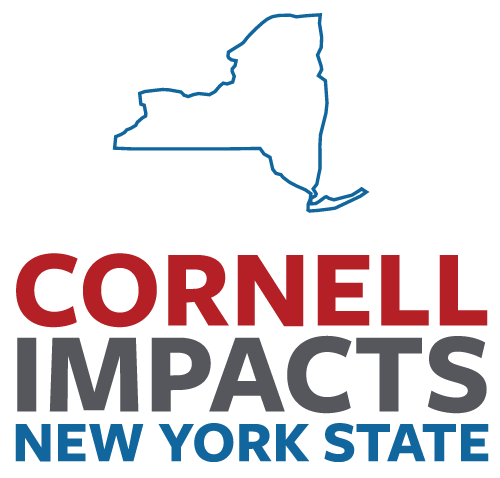
Crystal Nuñez, center, and Sky Domingo, second from right, discuss a lesson plan with teachers at Seymour Dual Language Academy in Syracuse. Nuñez, a senior at SUNY Cortland, is currently in the Community Neuroscience Initiative SUNY Scholars program; Domingo participated at SUNY Oswego and now teaches at Seymour Dual Language Academy. Other teachers pictured, left to right, are Johan Mangual, Rosario Anamaria and Lorraine Aviles.
Neuroscience helps teachers empower students and themselves
By Juan Vazquez-Leddon
As a senior in the Inclusive Childhood Program at SUNY Cortland, Crystal Nuñez is sharpening her teaching skills in the Syracuse City School District. While she is learning how to teach elementary-age children, she is also discovering – through lessons from Cornell researchers – how a young child’s brain functions and learns.
“I’ve learned everyone’s brain is different,” Nuñez said. “I feel like students don’t think that, that there’s a specific way you have to learn and do stuff, but there are multiple ways you can learn something.”
It’s one of the neuroscience lessons Nuñez and other student teachers have learned through the SUNY Scholars program, administered by the Community Neuroscience Initiative (CNI), a project in the Bronfenbrenner Center for Translational Research. The program provides student teachers an understanding on the neuroscience behind children’s learning and development and encourages them to pass that knowledge to their students.
The initiative partners with the New York State Education Department to offer SUNY Scholars to student teachers, or pre-service educators, in the Teacher Opportunity Corps II (TOC-II) program at SUNY Cortland and SUNY Oswego. The TOC-II program is the New York State Education Department’s effort to increase the rate of historically underrepresented and economically disadvantaged individuals in the teaching field.
“Neuroscience knowledge could help differentiate educators when they enter the job market,” said Marlen Z. Gonzalez, CNI’s director. “It also provides the children an understanding of what they may be experiencing and why.”
Pre-service educators learn neuroscience concepts through CNI’s Accessible Neuroscience Lecture Series, a monthly virtual lecture led by expert neuroscientists from across the country. Many of these neuroscientists come from underrepresented groups, and their curriculum focuses on how the brain works, how it learns and how environments – including the classroom – affect learning.
“The interaction between the environment and the brain is important,” Gonzalez said. “The kinds of experiences that teachers give their kids matter. The brain isn’t just pre-programmed to grow; it is deeply sensitive to what is in the environment.”
CNI staff members work with the SUNY Scholars to integrate their neuroscience knowledge into their current student-teaching lesson plans and provide support for these lessons.
“It’s meeting whatever needs the kids have at that moment,” said Gonzalez, who’s also an assistant professor of psychology in the College of Human Ecology. “We don’t come in and change the curriculum.”
Those needs can center on emotions and feelings that can affect a child’s learning ability, like hunger, safety threats and lack of sleep.
“I’ve noticed that some of our students are not getting enough sleep and they don't understand how that impacts their ability to self-regulate and focus, along with their hunger levels,” said Kuricheses Alexander, principal of STEAM at Dr. King Elementary in Syracuse. “All of this impacts their ability to engage in the learning process.”
Sky Domingo, a SUNY Scholar from Oswego, said the neuroscience concepts he taught students as a pre-service teacher at STEAM at Dr. King Elementary were particularly helpful, especially the lessons on self-regulation.
“You start to see the small, incremental changes, and habits start to form because you’ve explained these concepts and how your environment helps with that,” said Domingo, who now teaches at Seymour Dual Language Academy in Syracuse. “It was something that was eye-opening for them, as it was for me.”
“Children’s brains are like sponges and that’s why it’s exciting to have them learn about how their brain operates at such an early age,” Alexander said. “This gives them the knowledge and language to begin to advocate for themselves and express how or what they’re feeling. Plus it helps them see that they have a voice and it matters.”
It also helps the SUNY Scholars in their own classes. Nuñez has applied the lesson “everyone learns differently” to herself.
“For example, in math, there can be more than one way to solve a problem,” Nuñez said. “When I was a kid, I thought if I found the result differently, it was wrong. But now I know it’s not. Every student can have a different approach.”
Initially, CNI’s faculty and graduate students worked directly with schools to teach neuroscience concepts to children. But with the support from the state education department, CNI has realized the SUNY Scholars model is more beneficial and creates community.
“I had a principal come up to me and say, ‘We have people come in and out of our school from different programs, but when CNI is here, it just feels comfortable,’” said Gonzalez. “That’s it – that’s Community Neuroscience. That’s the goal.”
Juan Vazquez-Leddon is the communications director for the Bronfenbrenner Center for Translational Research.
Media Contact
Get Cornell news delivered right to your inbox.
Subscribe

